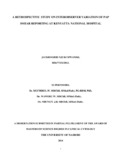| dc.contributor.author | Mwaniki, Jackrogers Njuki | |
| dc.date.accessioned | 2014-12-01T06:38:56Z | |
| dc.date.available | 2014-12-01T06:38:56Z | |
| dc.date.issued | 2014 | |
| dc.identifier.citation | Masters of science in clinical cytology | en_US |
| dc.identifier.uri | http://hdl.handle.net/11295/75666 | |
| dc.description.abstract | Background: Interobserver variation in the cytological diagnosis of cervical lesions poses a problem
for public health screening programs. Every screening program should have procedures in place to
minimize this. Establishing the degree of interobserver variation would inform decisions and
corrective action. This study assessed the frequency and degree of discordant diagnoses between the
primary and the review results of pap smears.
Objective: To determine the interobserver variation in pap smear reporting using the Bethesda System
(2001) at Kenyatta National Hospital
Study design: A laboratory based retrospective study.
Study area: The study was conducted at the KNH/UON cytology laboratory.
Study population: A total of 372 Pap smears previously reported as ASCUS or higher lesion at KNH
Cytology laboratory from Jan 2011 to June 2013 (30 months) were retrieved for the study.
Materials and method: Pap smears were selected and examined to determine the cervical changes and
graded using The Bethesda System of reporting cervicovaginal cytology first by the investigator then
together with the supervising Pathologists.The supervisors were blinded to the primary pathologist’s
report. The results were then compared with the primary report. In cases with discordance between the
primary and the review report, a third Pathologist acted as a tie breaker.
Results: Presence of mixed lesions (Squamous+Glandular) which had been missed in the primary report
were found. More than 22% cases were downgraded to NILM. Significant ‘overcalls’& ‘undercalls’
were also found. ASCUS had a kappa of 0.049, LSIL 0.045, HSIL 0.126, ASCH 0.231, SCC 0.376 &
Glandular lesions 0.125.Overall kappa was 0.327.
Conclusion: Overall inter-observer agreement was fair, but the concordance was lower than that
observed in other studies. LSIL and ASCUS lesions had very high discordance. The lesion with the best
interobserver agreement was SCC while HSIL lesions had an intermediate discordance.
Recommendations: Establishment of a stringent IQC/EQA programs in the department to improve
accuracy of reporting | en_US |
| dc.language.iso | en | en_US |
| dc.publisher | University of Nairobi | en_US |
| dc.title | A retrospective study on inter-observer variation of pap smear reporting at Kenyatta national hospital | en_US |
| dc.type | Thesis | en_US |
| dc.description.department | a
Department of Psychiatry, University of Nairobi, ; bDepartment of Mental Health, School of Medicine,
Moi University, Eldoret, Kenya | |
| dc.type.material | en_US | en_US |

